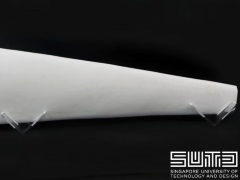Features
Natural approach to 3D printing
Date: 2018-07-16 10:31:03.0
Author: Jon Evans

Wind turbine blade printed with a composite of
cellulose and chitin called FLAM.
Photo: SUTD.
Bio-based materials are already proving of use in 3D printing (see Sweet smell of 3D printing). The bioplastic polylactic acid (PLA) is one of the most popular materials for a form of 3D printing known as fused deposition modeling (FDM), in which the material is deposited as a molten liquid that hardens as it cools to build up a solid object. But PLA could soon be joined by a whole range of other bio-based materials for 3D printing, and these will be derived directly from plant biomass, rather than having to be generated by microbes, as is the case with PLA.
In looking to develop printable materials from plant biomass, researchers have mainly been focusing on cellulose and lignin, as they provide plant cells with their strength and rigidity. On their own, however, cellulose and lignin don’t possess the right processing characteristics for 3D printing and so researchers are combining them with other materials to form composites that are more amenable.
Amit Naskar and his colleagues at Oak Ridge National Laboratory (ORNL) in Tennessee, US, tried combining lignin with the synthetic polymer acrylonitrile butadiene styrene (ABS), which is currently the most popular material for FDM. However, the resultant composite was too brittle and weak for 3D printing, with a tensile strength of just 20.5MPa.
To improve the physical properties, Naskar and his colleagues tried adding acrylonitrile butadiene rubber, which formed cross-links with the lignin molecules and so immediately increased the strength by 94%. They then increased the strength still further by adding 10% by weight of carbon fibers to reinforce the composite. As they report in a paper in Applied Materials Today, the final composite comprised 40% by weight of lignin but had a tensile strength of 65MPa and proved to be an excellent material for 3D printing by FDM.
Still, this material was partly made of synthetic polymers and the ideal bio-based material for 3D printing would comprise only biological materials. In looking to develop such an all-biological 3D printing material, Javier Fernandez and his colleagues at the Singapore University of Technology & Design were inspired by the cell wall of a fungus-like class of eukaryotic organisms known as oomycetes. These are the only organisms known to have a cell wall made of a composite of cellulose and chitin, which is more commonly found in the exoskeletons of arthropods.
Fernandez wondered whether a similar composite of cellulose and chitin could make an effective material for 3D printing, as the chitin helps to bind the cellulose fibers together. So they developed their own version, which they termed fungus-like additive material (FLAM), by mixing cellulose with a solution of chitin in acetic acid. As they report in a paper in Scientific Reports, this composite could be printed by a technique known as direct ink writing, in which the material is printed as a paste that hardens as it dries. As a first demonstration, they used this technique with FLAM to print a 1.2m-long wind turbine blade.
Rather than developing bio-based materials for printing the same kind of objects as synthetic materials, a team of Estonian scientists led by Toomas Tenno at Tartu University has developed a novel bio-based material that can be used to print an entire house. Their material is a composite of peat and combustion fly ash, which acts as a binder and helps the composite to harden after it’s printed. If necessary, they can also incorporate nanoparticle additives, such as nanosilica, into the composite to enhance its properties.
As reported in a paper in Sustainable Materials and Technologies, they developed a bespoke system for printing a 3–5mm-thick layer of this material in each pass and showed how it could be used to print large blocks, walls and ceilings. The material is naturally thermally insulating and sound proof, and Liiv and his colleagues calculate that printing a house with it would reduce construction costs by a factor of 10.
The views represented here are solely those of the author and do not necessarily represent those of John Wiley and Sons, Ltd. or of the SCI.
Displaying 2 keywords used to tag this article:
- Jules Audemars-Australia Best Quali
- DG6582 Mens Moncler Down Jackets Gr
